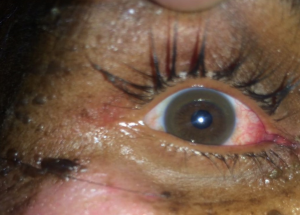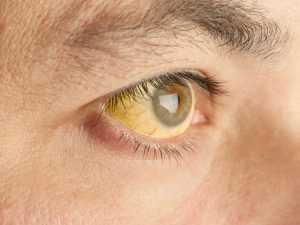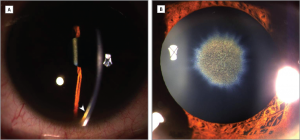This is a story of a young homeless man who was lying in a street, brought to our hospital by the rescue team and later diagnosed with a rare disease – Wilson disease.
History and examination:
A young man was brought to the emergency in an unconscious state with no identity available by the rescue team. He was found lying in an unconscious state at a roadside.
On examination, he had a GCS of 7/15 with stable vital signs. He had an unkempt appearance with superficial wounds on the forehead, nasal bridge and cheeks. He was moderately dehydrated with sunken eyes.
Pupils were equal and reactive to light. He was moving all four limbs, with no signs of meningeal irritation. Systemic examination was unremarkable.
In the emergency department, his plasma sugars were 48 mg/dl so he was given 25% dextrose water after which he improved.
The patient was re-evaluated when he was conscious. He was confused, dysarthric with abnormal movements and cogwheel rigidity.
https://twitter.com/fever_pk/status/1053688580818812929
Eye examination of the patient revealed a characteristic sign – the Kayser Fleischer rings

Serum ceruloplasmin was 4.7 mg/dl (15 – 30)
MRI of the patient was done which showed another characteristic sign of the disease – the Panda sign

The patient was diagnosed as a case of Wilson disease.
A brief overview of Wilson disease:
Wilsons disease is a rare autosomal recessive disease of copper metabolism. Genetic defect leads to impaired copper excretion and hence accumulation of copper in various organs. Liver, brain, and pancreas are the major organs affected by the disease.
Clinical manifestations:
Most patients present between 5 and 35 years of age. Although copper accumulation begins in early childhood. Children usually present with symptoms related to liver disease while adults and patients in their late teens usually have predominant neurological features.

Hepatic manifestations in Wilson disease:
Patients with hepatic disease may present with stigmata of liver disease. These include jaundice, hepato-splenomegaly, spider angiomas or even with complications of liver disease. Patients may also present with acute liver failure, variceal bleed, encephalopathy, and ascites. However, most patients are asymptomatic and picked up on routine investigations. Liver enzymes are deranged but alkaline phosphatase may be low.
Neurological manifestations of Wilson disease:
Neurological features may be subtle but at times may be rapidly progressive leading to severe disability. These features are secondary to basal ganglia dysfunction. Patients may present with features of Parkinson’s disease-like rigidity, tremors, and bradykinesia. Other neurological features of Parkinson’s disease include dysarthria, dystonia, gait abnormalities and/ or a combination of all these features. Patients may also present with seizures, dystonia, chorea, athetosis, and cognitive impairment.
Other manifestations of Wilson disease:

Other features of Wilson disease include a Coombs negative hemolytic anemia, Kayser-Fleischer rings (brownish or gray-green rings that are due to fine pigmented granular deposits of copper in Descemet’s membrane in the cornea). Sunflower cataract may develop as well.
Other rare manifestations include Fanconi syndrome, renal calculi, arthropathy, gigantism, cardiomyopathy, hypoparathyroidism, pancreatitis, hypogonadism, and infertility.
Diagnosis of Wilson disease:
Diagnosis may be challenging in some cases. Increased urinary copper excretion with low ceruloplasmin and hepatic copper accumulation are characteristic features. Other features in patients with Wilson’s disease include a Coombs negative hemolytic anemia, neurologic symptoms, and the characteristic Kayser Fleischer ring on the outer surface of the cornea. MRI of the brain may show increased basal ganglia, cerebellum and brainstem copper accumulation. If available, mutations for ATP7b can be diagnostic.
Treatment of patients with Wilson disease:

Early initiation of treatment prior to a liver or neurological damage is essential. Patients should be advised to avoid copper containing diets like seafoods, nuts, mushrooms, and chocolates.
Drug therapy includes oral penicillamine (drug of choice) which enhances urinary copper excretion. Patients who can not tolerate penicillamine (because of gastrointestinal intolerance, hypersensitivity, autoimmune reactions, nephrotoxicity or bone marrow toxicity), trientine may be used. Oral zinc may be added to reduce copper absorption. Zinc may be used as a first line agent in presymptomatic or pregnant patients and those with neurologic disease. Liver transplantation is indicated for fulminant hepatitis, end-stage cirrhosis and rarely in patients with intractable neurologic disorders.
Screening of relatives of a patient with Wilson disease:
All first degree relatives, especially siblings require screening with serum ceruloplasmin, liver function tests, and slit lamp examination.

In conclusion:
Homeless and mentally subnormal patients need a physician’s extra time. Not all individuals lying in streets are drug users, some have a story to tell.